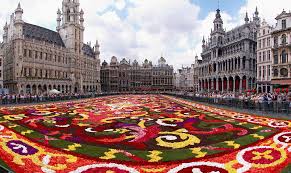Showing posts with label Belgium and Netherlands - Flemish Béguinages. Show all posts
Showing posts with label Belgium and Netherlands - Flemish Béguinages. Show all posts
Wednesday, 13 April 2022
FRANCE
This cover came from France and depicts 2 stamps. The stamp on the left is part of a set issued in 2016 celebrating the Netherlands capital, Amsterdam. It shows a picture of Le béguinage. A beguinage (from the French béguinage) is an architectural complex which was housing beguines. They were mainly built in Flanders and the Netherlands, but there are few in North-East France and North-West Germany. A beguinage usually included an inner court, houses facing this garden and a church, or a chapel. There were often walls surrounding the entire complex, separating it from the rest of the town and one or two gates to get in. Some would also include a convent or an infirmary. Beguinages were built around the XIII century and generally abandoned in the XIX-XX century. They are nowadays almost always UNESCO sites (inscribed in 1998). Their maintenance and look is protected and conserved as pieces of art. And their houses are often considered trendy areas where artists live. Amsterdam beguinage is an architectural jewel. It was originally surrounded not only by walls, but by the canals too. The entrance used to be a bridge, but nowadays there’s a more handy gate to give access to the inner garden and the church. This beguinage has an interesting history. In 1578, when Amsterdam turned Calvinist, practicing any other religion was forbidden. But since its houses were actually private properties, the beguinage had a special status of freedom. Its real churchwas officially closed down, but in 1671 two of the houses were reshaped into a chapel. It perfectly worked as a well hidden underground church thanks to the fact that all those buildings had no windows towards the city but only to the inner courtyard. .
Tuesday, 13 June 2017
BELGIUM
A nice UNESCO cover from Belgium, depicting a complete set issued in 2000 with 3 Unesco places in thheir own country:La Grand-Place (Great Square) in Brussels, the Flemish Béguinages and The Four Lifts on the Canal do Centre.
La Grand-Place in Brussels (since 1998) is a remarkably body of public and private buildings, dating mainly from the late 17th. century. The architecture provides a vivid ilustration of the level of social and cultural life of the period in this important political and commercial centre.


The Béguines were women who dedicated their lives to God without retiring from the world. In the 13th century they founded the béguinages,enclosed communities designed to meet their spiritual and material needs. The Flemish béguinages (inscribed at Unesco sites since 1998) are architectural ensembles composed of houses, churches, ancillary buildings and green spaces, with a layout of either urban or rural origin and built in styles specific to the Flemish region. They are a fascinating reminder of the tradition of the Béguines that developed in north-western Europe in the Middle Ages.


The Four hydraulic boat-lifts (inscribed as Unesco places since 1998) of the historic Canal du Centre are industrial monuments of the highest quality. Together with the canal itself and its associated structures, they constitute a remarkably well-preserved and complete exemple of a late 19th. century industrial landscape. Of the eight hydraulic boat-lifts built at the end of the 19thb century and beggining of the 20th century, the only ones in the world still existing in their original working condition are these four lifts on the Canal du Centre.


La Grand-Place in Brussels (since 1998) is a remarkably body of public and private buildings, dating mainly from the late 17th. century. The architecture provides a vivid ilustration of the level of social and cultural life of the period in this important political and commercial centre.
The Béguines were women who dedicated their lives to God without retiring from the world. In the 13th century they founded the béguinages,enclosed communities designed to meet their spiritual and material needs. The Flemish béguinages (inscribed at Unesco sites since 1998) are architectural ensembles composed of houses, churches, ancillary buildings and green spaces, with a layout of either urban or rural origin and built in styles specific to the Flemish region. They are a fascinating reminder of the tradition of the Béguines that developed in north-western Europe in the Middle Ages.
The Four hydraulic boat-lifts (inscribed as Unesco places since 1998) of the historic Canal du Centre are industrial monuments of the highest quality. Together with the canal itself and its associated structures, they constitute a remarkably well-preserved and complete exemple of a late 19th. century industrial landscape. Of the eight hydraulic boat-lifts built at the end of the 19thb century and beggining of the 20th century, the only ones in the world still existing in their original working condition are these four lifts on the Canal du Centre.
Subscribe to:
Posts (Atom)

